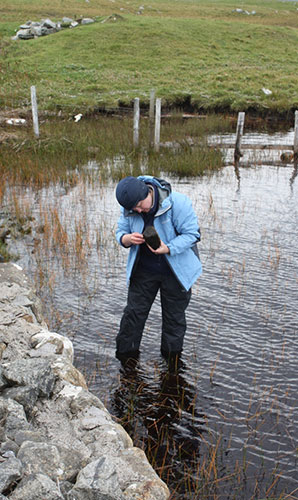In September 2012 Invertebrate Biologists Susan Chambers, Fiona Ware and Sankurie Pye, from the Department of Natural Sciences, ran a survey of 23 saline lagoons in the Uists, Outer Hebrides as part of a study commissioned by Scottish Natural Heritage.
The aims of the study included producing a permanent collection of botanical and zoological specimens with an emphasis on specialist lagoon species. All the specimens have now been identified and we have incorporated nearly 600 jars of invertebrates into our collections at the National Museums Collections Centre and prepared over 250 botanical specimens for incorporation into the collections of the Royal Botanic Garden Edinburgh.

So what are saline lagoons, why are they important and what did we find out?
Saline lagoons are shallow bodies of salty water which are wholly or partially separated from the nearby sea. In some lagoons the saltiness of the water can fluctuate dramatically over time and in others there can be a distinct salinity gradient from almost marine conditions to almost freshwater conditions as distance from the influence of the sea increases. This rare and vanishing habitat is recognised under the UK’s Biodiversity Action Plan and is considered a priority habitat (‘in danger of disappearance’) under the European Habitats Directive. The threats to saline lagoons include sea level rise, pollution and human disturbance.

The Uists are known to have some of the finest lagoons in Europe but there was insufficient knowledge of the plants and animals living in them to inform a strategy for monitoring the conservation status of these internationally important sites. Our work has significantly increased this knowledge and has ensured that a voucher collection of the specialist, rare and potentially threatened invertebrates and plants that live in these lagoons are available in perpetuity. We recorded 243 species including lagoon shrimps, slaters, snails and cockles and nationally rare species including the foxtail stonewort. We also established several new records including the tube dwelling polychaete worm Ampharete acutifrons and the non-native barnacle Austrominius modestus which has gradually been spreading around the British Isles but has not previously been recorded from the Uists.

The next step is to publish these interesting results and to continue our research into lagoon specialist species including a collaborative study with Heriot-Watt University on the molecular taxonomy of lagoon mud snails.
Thank you to Bill Crighton, Natural Sciences Volunteer, for his amazing photographs including the one shown above of Corophium volutator.
